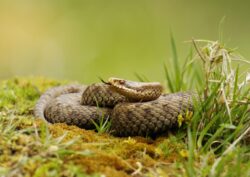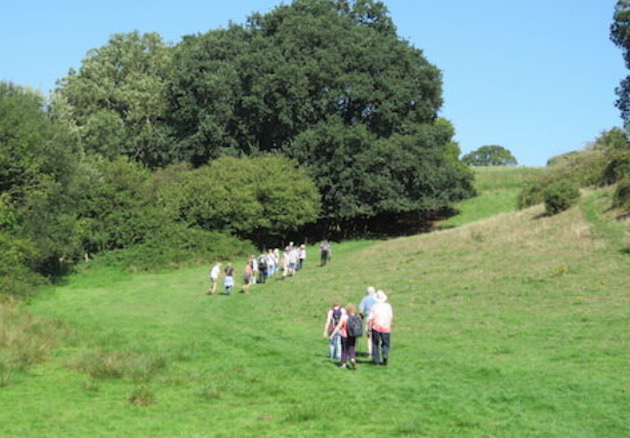 Abraham Lincoln
If given the truth, the people can be depended upon to meet any national crisis...
Abraham Lincoln
If given the truth, the people can be depended upon to meet any national crisis...
 Guildford news...
for Guildford people, brought to you by Guildford reporters - Guildford's own news service
Guildford news...
for Guildford people, brought to you by Guildford reporters - Guildford's own news service
AI Technology at the Forefront of Surrey Conservation Project
Published on: 6 Jun, 2025
Updated on: 8 Jun, 2025

Puttenham Common. Jon Hawkins
By David Reading
In a ground-breaking conservation project making use of Artificial Intelligence, teams of volunteers are being deployed to record the plant species which thrive on rare acid grassland habitats such as Puttenham Common.
The volunteers will visit sites of major importance using a specially-designed app to record plants found in these rare habitats. Artificial Intelligence will then be used to accurately match specific types of habitat with similar habitats close by, using satellite Earth Observation images.
In this way, large-scale plans can be developed to join up and protect these green spaces in a way that works best for wildlife.
 The project called Space4Nature is a trailblazing habitat mapping and conservation project led by Surrey Wildlife Trust (SWT) and the University of Surrey. Local people are being invited to volunteer.
The project called Space4Nature is a trailblazing habitat mapping and conservation project led by Surrey Wildlife Trust (SWT) and the University of Surrey. Local people are being invited to volunteer.
SWT says lowland dry acid grassland is found in former agricultural landscapes on acidic, often sandy, soils. These distinctive, threatened places can host up to 25 plant species per square metre.
In addition to fine grasses, lichens and mosses, these include species such as mouse-ear hawkweed, herbs such as sheep’s sorrel, and tiny annuals such as common stork’s-bill, changing forget-me-not, and parsley piert.

The adder – found in the kind of habitat being studied. Jon Hawkins
Dry acid grassland can also serve as vital habitats for ground-nesting birds including skylarks, reptiles such as adders and rare invertebrates including several cricket, bee and wasp species.
Dan Banks, Citizen Science Officer for the Space4Nature Project, said: “Conservation is increasingly reliant on new technologies to develop solutions that can be implemented at scale. But that doesn’t mean that old fashioned ‘ground truthing’ [a process of validating data] isn’t needed too.
“As the Artificial Intelligence capabilities being developed by our colleagues at University of Surrey become more sophisticated, we need more complex data to help them keep learning and evolving. With the climate and nature crisis becoming more severe, local people with an interest in nature can make a real difference by getting involved in local projects like Space4Nature.”
Over the last two years, Space4Nature has deployed more than 200 volunteers to some of the county’s most important chalk grassland, wetland and heathland habitats, including Chobham Common, Unstead wetland reserve, Sheepleas and Puttenham Common, to help inform the initial development of its AI programmes.
And through a partnership with Buglife’s B-Lines project, it also worked to create and connect more than 60 hectares of habitat for pollinators, including St Martha’s Hill outside Guildford.
Space4Nature has already been running for two years but what is new is the extension of its operations to more acid grassland and wetland habitats, to help provide a more comprehensive understanding of Surrey’s most important places for wildlife, and what steps might be taken to connect them up.
Learn more about Space4Nature, a three-year project made possible by players of People’s Postcode Lottery, and how you can get involved as a volunteer.
Recent Articles
- News from Voluntary Action South West Surrey, Autumn 2025
- Announcing The Winner Of Our Short Story Competition
- Notice: Big Draw Festival Celebrating Railway 200
- Rogue Builder Sentenced
- Football Legends Immortalised Book Kicks off Again With a New Publisher
- Guildford By-election – Read What the Candidates Have to Say
- Man Seriously Injured and Homes Evacuated in Firework Incident
- Meet Your SCC Candidates – Catherine Houston for the Lib Dems
- Meet Your By-Election Candidates: Claire Whitehouse for Greens
- Meet Your By-Election Candidates: Alex Fiuza for the Conservatives



Search in Site
Media Gallery
Cllr Townsend on Waverley’s CIL Issue
August 27, 2025 / Comments Off on Cllr Townsend on Waverley’s CIL Issue / Read MoreMP Zöe Franklin Reviews Topical Issues
August 27, 2025 / Comments Off on MP Zöe Franklin Reviews Topical Issues / Read MoreMP Hopes Thames Water Fine Will Be ‘Final Nail in Its Coffin’
August 27, 2025 / Comments Off on MP Hopes Thames Water Fine Will Be ‘Final Nail in Its Coffin’ / Read MoreNew Guildford Mayor Howard Smith
August 27, 2025 / Comments Off on New Guildford Mayor Howard Smith / Read MoreA New Scene for a Guildford Street
August 27, 2025 / Comments Off on A New Scene for a Guildford Street / Read MoreDragon Interview: Sir Jeremy Hunt MP on His Knighthood and Some Local Issues
August 27, 2025 / Comments Off on Dragon Interview: Sir Jeremy Hunt MP on His Knighthood and Some Local Issues / Read MoreDragon Interview: Paul Follows Admits He Should Not Have Used the Word ‘Skewed’
August 27, 2025 / Comments Off on Dragon Interview: Paul Follows Admits He Should Not Have Used the Word ‘Skewed’ / Read MoreDragon Interview: Will Forster MP On His Recent Visit to Ukraine
August 27, 2025 / No Comment / Read MoreDragon Interview: Fiona Davidson on the ‘Devolution’ Proposals for Surrey
August 27, 2025 / No Comment / Read More












Recent Comments